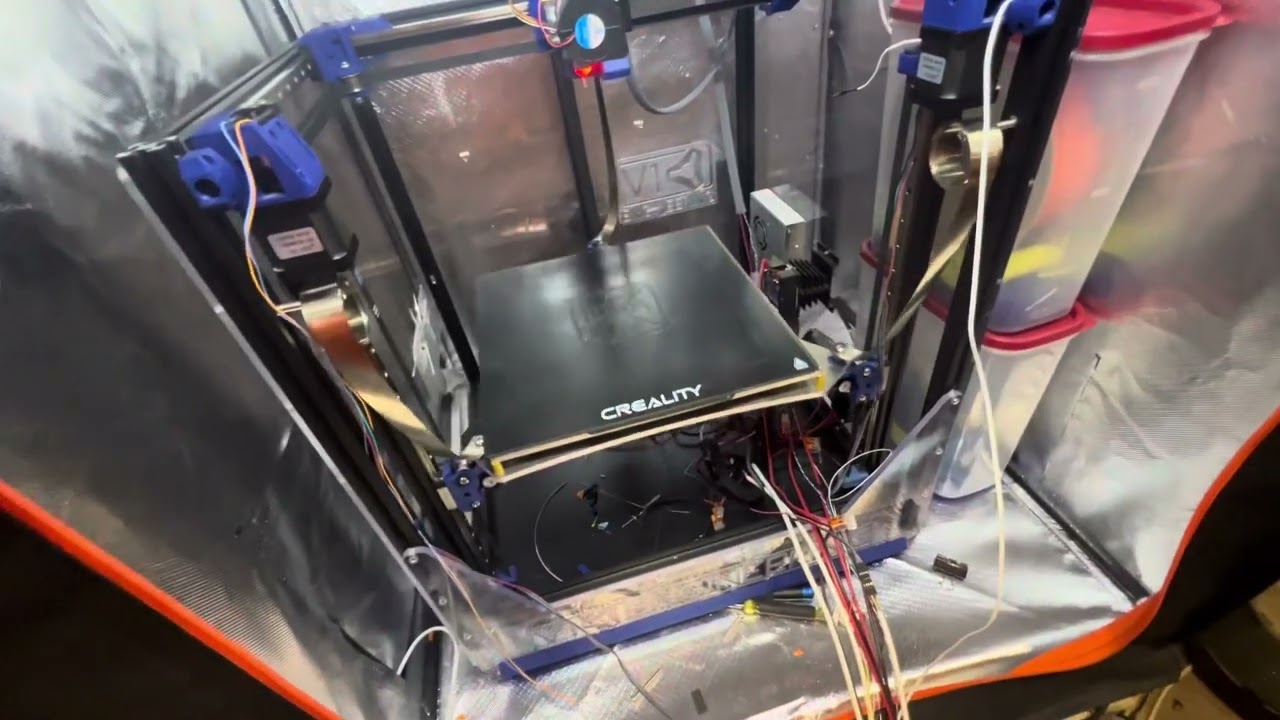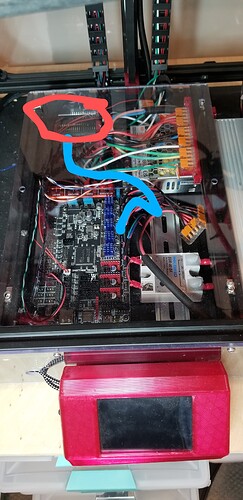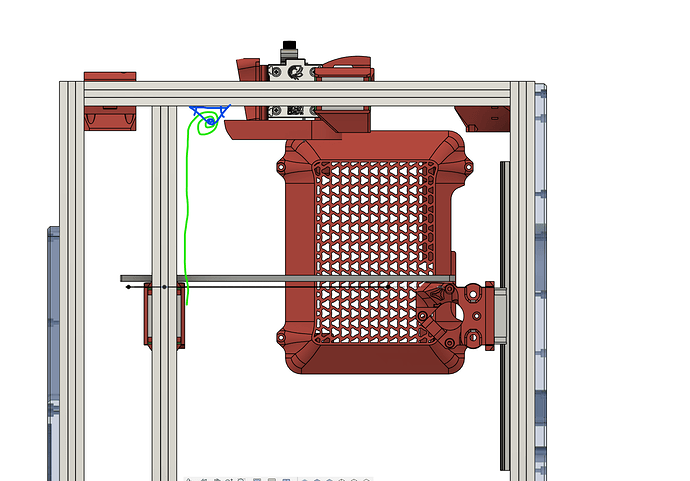Hey @pavel569, happy with your tension spring setup? Any changes, or changes you’d like to see?
Agree with this.
Another question is whether one could just put some large zeners on the power supply rails so that you can’t ever take them over the damage threshold. On the SKR Pro, it’s U2 that’s getting killed:
The fuses aren’t blowing, so we’re either reverse biasing something or we’re overvolting the 5v rail. My bet is we’re overvolting it.
Ryan- can you do a characterization test?
Disconnect the steppers from one of your printers’ control electronics so you don’t blow up a board.
Do this first with a DMM in voltage mode across one coil. use 100v range.
Move the bed up to Z max. Place a 3-4 lb object on the bed, and make sure you protect from the drop messing up your frame.
Let it drop.
How high is the max voltage (It will probably be worse than your DMM shows, and what polarity?)
I’m betting that if we look carefully at what happens it will explain why the SKRs regulators are blowing and probably be a bit of a forehead slap.
If you have an already dead SKR (but one that didn’t blow the regulator) with otherwise bad 2209s, do a smoke release test with the instrumentation hooked up- maybe even with the scope (Probes and scope set to the highest voltage setting if it is safe to do so given the peak voltage above)
NOTE: Yes, all over everywhere are warnings to machine users not to move the machine by hand or at high rates when drivers are connected but not powered/enabled. This is a well known problem. I’m being lazy as I bet there are good papers written about this in the literature. I first blew up a controller this way in about 2014 when I first encountered a LulzBot AO100. That wasn’t a Z drop, dumb butt me just moved the print bed backwards by hand at a reasonably fast clip because I wasn’t thinking. (Bed slinger printer) The first of many RAMPS boards I killed.
@vicious1 or anyone else, is there anything further you would like me to check with these springs before I take them off so I can start printing again? Going to have to come up with a better way to mount them permanently but that’s tomorrows problem lol.
Now let’s get one without the springs for comparison ![]()
Have been hoping springs are cheap and good enough. But…
Whether or not tension springs or counter balance end up being recommended… Am also hoping this topic ends up with a “Stepper extension board” being created with 6 pairs of connectors. That minimally has over-voltage protection for the controller on at least 3 of the connector pairs for the Z steppers.
Given bang for buck priority… Out of the following two requirements, 2) seems to be the priority? Especially if people avoid Alu for Bed Support plate. Just use Alu for Bed.
- “stop the bed hitting hard stops at speed”
- “avoid an over-voltage on the stepper driver boards”
Controller protection seems more important than physical braking/slowing/halting hard drop? Physical damage from hard drop can be mitigated using cheap TPU/rubber bumper, or TPU whoopee cushion maybe?
Came close to making a dumb connector board for my enclosure (without voltage spike protection). Currently just have a simple 3D printed DuPont shell holder thing (red circle) has been good enough to extend stepper wires to controller using premade 12" 22AWG DuPont extension cables (blue squiggly)…
Personally would buy a fairly priced connector board. But not the $50 brake boards per stepper that are close to the cost of a SKR…
You buy the next SKR and I’ll do it no problem LOL
That’s a HUGE improvement. Maybe mechanical limiting is the way.
I don’t disagree. Its just figuring out the right way to mount them out of the way of everything else. A good way is not jumping out at me right now. I was looking at it all when I was putting them on. But I am NOT a designer that’s for sure.
Interesting: (I never knew there was an online EMF calculator. Of course RepRap would host it)
Ooh- and someone makes a silent stepper protector assembly!
Edit to add- and it is open source!
That will probably be doing what the TMC2209 is already doing in this case. It’s just re-directing the induced current into the rails, which is what the issue seems like here if the main board is dying while the stepper drivers are fine.
I think the thing is that 1) will also prevent 2) in most of the cases. 2) will not necessarily prevent 1).
Doing both would be ideal, but may need to cover too many corner cases to be worth doing, at least in one design.
Adding over-voltage protection of some kind to the input of the SKR boards may be a better approach to solving that if it’s just those specific boards that are brittle due to regulator choice.
I wasn’t saying clearly what this simple board opens up…
Imagine a variant of this that places the required protection for whatever rails need it - on the intermediate board. It could also provide a connectorized place to break out the enables and maybe diode OR them together. So that then could be the way to get the enables over easily over to a “brake module” without otherwise having to modify the boards with brittle regulator designs.
Edit: Changed to say “protection” and “whatever rails” based on the good feedback below.
Ah, I follow now. It’s a great option for adding an active brake module and that would easily work with the size constraints of that board.
For adding zeners, I don’t think it’s the 5V rail that will be the issue, it’ll be the Vmot as that’s likely where the output drivers will be bypassing to.
It would be one way to add the zeners, although they could be added anywhere that connects to Vmot, if what I’m thinking is right. I’d also be a little leery of just doing it with zeners as they tend to be pretty variable in their specs. Set the Vr too low and they leak/overheat under high line conditions. Set them too high and their dynamic impedance doesn’t let them sink enough current to protect things. It’d be interesting to know what the actual threshold on the SKR boards is before damage occurs. Doing some form of SCR based crowbar isn’t too hard, if that is the case.
wouldn’t a strategically placed TVS diode help with the overvoltage?
I made a board once with them and it protected against reverse DC power and overvoltage.
I started looking into that the other day, but I wasn’t sure at the time what we are actually dealing with that’s causing the board to burn
I also wasn’t sure whether the normal operation voltage was one-directional, and whether it was always going to be one direction or the other in the fail case.
Nice!
Okay, that gives me some hope! This by no means is a huge priority but something I want to pursue further. I guess I can start with a clear list of needs and wants.
Possible to got to a lower fuse for F4? That would be a rad fix.
I have a one all rigged up and was hanging weights from it. I can easily get a single coil voltage but my meter is a bit slow.
I got nearly 10V with a 5lb weight on a single coil near free fall. So multiply that by 6 coils?
That is the reason I changed to the Rambo’s. Barry introduced me to Johnny R and he had me jerk around a printer long enough to boot the board and use the LCD menus. We powered the board in reverse and nothing happened. I figured every board since then had that protection…that is what I get from assuming.
Still too fast I think but way better I am sure.
Agreed
Seems like this and a TPU Bumper could be all we need??
DAng…Such a roller coaster.
I had an unexpected bed drop yesterday, and without the glass on there no magic smoke. so the difference between 8.5 and 10.5 is where the problems come in. And I’ve also had some with the glass on that don’t burn it either. Idk what the difference is. So maybe 8.5 still is enough and I just got lucky yesterday.
The springs help a ton. and that second video I added the glass back on there just to make it heavier. I ordered 2.4 lbs. springs.
Still have to come up with a way to mount them permanently. my quick idea for testing wouldn’t work out long term
CrayonCAD, this is what I picture. Or it could even be part of the upper Z belt if this was the recommended fix.
That is good to know. So the board do handle a significant load, just not ~60V maybe 50V
That’s what I was thinking. I have the V4 CAD pulled up at home and was going to attempt to draw up something I just don’t know what yet lol. And I have to figure out something for the back to keep it lower than the belts and still high enough to home.
It’s a lot less violent drop at the lower weight that’s for sure. Still violent, but less lol



